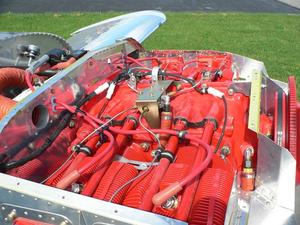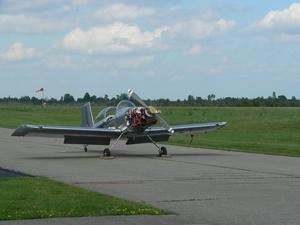I was on the road for most of the week, so today was the first chance I had to go to the hangar since Monday.
 The big task I wanted to get done today was the first engine start. In the morning, I tidied up some loose wiring ahead of the firewall, and found ways to secure all the plug wires. I secured the Bowden cable for the alternate air door, to keep it from rubbing on the plug wires.
The big task I wanted to get done today was the first engine start. In the morning, I tidied up some loose wiring ahead of the firewall, and found ways to secure all the plug wires. I secured the Bowden cable for the alternate air door, to keep it from rubbing on the plug wires.
Then I pulled the two Mooneys out of the hangar, so I could get the RV-8 outside. It felt really, really good to finally have the aircraft outside. I put some avgas in the fuel tanks, then tried the boost pump - no fuel pressure - it was not managing to pull any fuel. This was an expected problem, as apparently the seals in the Airflow Performance boost pump dry out. About this time I realize that there was a major fuel leak in the cockpit. I discovered a fuel fitting that was very, very loose.
I disconnected the fuel line from the input to the fuel injector servo, then put a piece of flexible hose over the fuel vent from the left fuel tank, put the fuel selector on the left tank, and gently blew in the fuel vent line to push some fuel up to the boost pump. I selected the boost pump back ON, and immediately heard the sound change, as it was now pumping fuel - a stream of fuel was pumped out the disconnected fuel line. I stopped the boost pump, and reconnected the fuel line.
Next, I needed to crank the engine to build oil pressure before attempting a start. I removed the upper spark plugs, then cranked - the display on the EIS 4000 engine monitor died when I cranked, as the voltage dropped too far. But, the LOW OIL PRESSURE red light in the annunciator light group, is driven by an independent pressure switch. It extinguished after about 15 seconds, indicating that the oil pressure was greater than 15 psi. The display on the EIS 4000 came back to life as soon as I released the starter, and it showed 25 psi of oil pressure.
 I pulled the aircraft out onto the taxiway in front of the hangar line, and chocked it. I grabbed my test card, climbed in the aircraft and strapped in. I ran through my test card, and got to the point where I was to attempt to start the engine. The engine fired, but I was too slow to get the mixture control to full rich, and it died. I cranked again - nothing. I reprimed it, and cranked again - it fired again, then died. I couldn’t get it to fire again, and the battery eventually started to run down, so I stopped. I pulled it back into the hangar, and put the battery on the battery charger.
I pulled the aircraft out onto the taxiway in front of the hangar line, and chocked it. I grabbed my test card, climbed in the aircraft and strapped in. I ran through my test card, and got to the point where I was to attempt to start the engine. The engine fired, but I was too slow to get the mixture control to full rich, and it died. I cranked again - nothing. I reprimed it, and cranked again - it fired again, then died. I couldn’t get it to fire again, and the battery eventually started to run down, so I stopped. I pulled it back into the hangar, and put the battery on the battery charger.
Reviewing the sequence of events, I realized that I had made several errors. First, I had not taken the time to review the engine start section of the Lycoming Operators Manual. I had simply used the checklist I made, which was effectively a translation of the procedure in the manual. But, looking at the manual again, I see that I was way too slow to push the mixture forward. And, when I tried to reprime the engine, I now realize that I had left the throttle back, rather than pushing it full forward, so very little fuel would have flowed.
Assuming the rain holds off tomorrow, I’ll try again in the late afternoon. Meanwhile, I will read my collection of e-mail list messages about start techniques for Lycoming engines with Bendix fuel injection systems. The start procedures are quite different from the ones for carburetor equipped engines that I am more used to.
I was really looking forward to the first engine start today, but I'm not too bummed out, as I got fairly close. The big event should happen sometime this week.